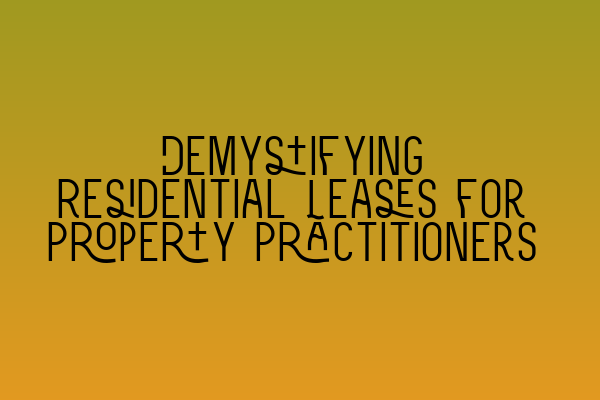Demystifying Residential Leases for Property Practitioners
As property practitioners, it is crucial to have a solid understanding of residential leases. These legal documents play a significant role in property transactions and can often be complex and confusing. In this blog post, we aim to demystify residential leases, providing you with a comprehensive guide to help you navigate this aspect of property law with confidence.
What is a Residential Lease?
A residential lease, also known as a rental agreement, is a legally binding contract between a landlord and tenant. It outlines the terms and conditions of the tenancy, including the rights and responsibilities of both parties. Residential leases are commonly used when renting residential properties such as houses, apartments, or condominiums.
Now that we have a basic understanding of what a residential lease is, let’s dive deeper into its key components.
Key Components of a Residential Lease
1. Parties Involved: The lease should clearly identify the landlord (property owner) and tenant (individual or entity renting the property). Both parties should be identified by their full legal names and addresses.
2. Property Description: The lease should include a detailed description of the leased property, including its address, unit number (if applicable), and any specific features or amenities.
3. Term of Lease: The lease must specify the duration of the tenancy, whether it’s a fixed-term lease (e.g., one year) or a periodic lease (e.g., month-to-month). It should also outline any provisions for renewal or termination.
4. Rent and Payment Terms: The lease should clearly state the amount of rent, how it is to be paid (e.g., monthly, quarterly), and the due date for each payment. It should also address any late payment penalties or consequences for non-payment.
5. Security Deposit: Many residential leases require tenants to provide a security deposit as a form of protection for the landlord. This section should outline the amount of the deposit, its purpose, and any conditions for its return at the end of the tenancy.
6. Maintenance and Repairs: The lease should specify the responsibilities of both the landlord and tenant regarding property maintenance and repairs. It should outline who is responsible for certain tasks, such as lawn care, pest control, or appliance repairs.
7. Tenant Obligations: This section should outline any specific obligations or restrictions on the tenant, such as noise restrictions, pet policies, or limitations on modifications to the property.
8. Landlord Obligations: Similarly, the lease should outline the responsibilities of the landlord, including providing necessary repairs, maintaining common areas, and respecting the tenant’s right to quiet enjoyment of the property.
9. Termination Clauses: The lease should include provisions for lease termination, including notice periods required for both the landlord and tenant. It should also address circumstances that may warrant early termination, such as breach of contract or sale of the property.
10. Dispute Resolution: Finally, the lease should outline the process for resolving disputes between the landlord and tenant, such as mediation, arbitration, or court proceedings.
Tips for Drafting a Residential Lease
When drafting a residential lease, it is important to ensure its enforceability and protect the rights and interests of both the landlord and tenant. Here are some tips to keep in mind:
1. Use Clear and Concise Language: Avoid legal jargon and use plain, understandable language to make the lease accessible to all parties involved.
2. Include All Key Terms: Make sure to include all the necessary terms and conditions discussed earlier to leave no room for ambiguity or misunderstanding.
3. Consult Local Laws: Familiarize yourself with the local laws and regulations governing residential leases in the specific jurisdiction where the property is located. Consider incorporating necessary clauses or disclosures to comply with the law.
4. Seek Legal Advice: It is always wise to seek legal advice from a qualified property solicitor when drafting or reviewing a residential lease. They can guide you through the process and ensure compliance with all relevant legal requirements.
Conclusion
Residential leases are an integral part of property transactions, and as property practitioners, having a thorough understanding of their key components and nuances is crucial. By demystifying residential leases, we hope to empower you with the knowledge and confidence to navigate this aspect of property law effectively.
At SQE Property Law & Land Law, we are committed to providing expert insights and guidance to help you excel in property law. For further reading on related topics, we recommend the following articles:
- Understanding Contractual Capacity: Rights and Limitations
- Interactive SQE Mock Tests for Contract Law: Test Your Knowledge
- Join Our SQE Contract Law Webinars: Expert Insights and Guidance
- Contractual Capacity: Understanding Legal Competence in Contracting Parties
- Contract Law Reforms: An Analysis of Recent Changes
Feel free to explore these articles to deepen your knowledge in related areas of property and contract law.
Disclaimer: This blog post is for informational purposes only and should not be construed as legal advice. Always consult with a qualified solicitor for advice on specific legal matters.
